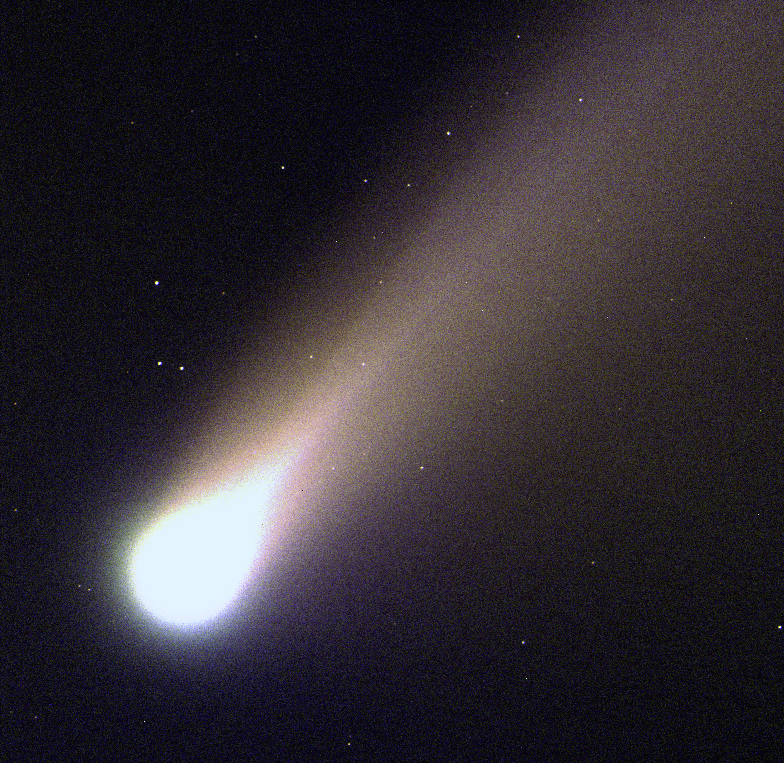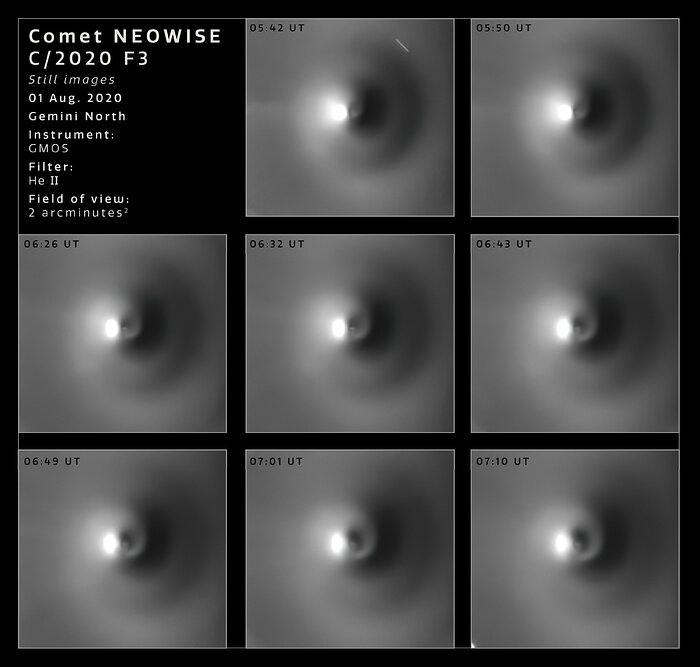Astronomy Object of the Month: 2020, December
< previous Archive next >
The rotation of Comet NEOWISE
Comet C/2020 F3 (NEOWISE) embellished the 2020 summer sky. It left many memories and beautiful photos, but, most of all, valuable scientific data. The international Gemini Observatory in Hawaii was used to observe the comet by the team led by Michał Drahus from the JU Astronomical Observatory in Krakow. The obtained observational data allowed for a detailed study of the material evaporated from the comet as it traveled through the inner regions of the Solar System.

Illustration 1: Comet NEOWISE photographed on July 21, 2020 with the automatic CDK500
telescope at the Astronomical Observatory of the Jagiellonian University. This color image is a composition of pictures taken in separate
BVR filters (Johnson-Cousins). Credit: OAUJ/S. Zoła.
Comets consist of ices, rocks, and dust left over from the formation of our Solar System. Some comets follow highly elongated orbits which send them close to the Sun where they warm up and cause the frozen gases to vaporize, releasing molecules and debris into space.
It is thought that most comets release gasses in geyser-like jets and that is what researchers think is happening in the Gemini images. As the vaporized material erupts from the comet its rotation causes it to appear to spiral outward, much like the water from a spinning garden hose. The very same material impacts the comet’s rotation causing its nucleus to spin-up or spin-down, though for most comets, the effect is too weak to detect.
When Comet NEOWISE (C/2020 F3) sped through the inner Solar System during the middle of 2020, astronomers and the general public watched in awe as this “dirty snowball” shed gas and dust into space, producing a striking show visible to the naked eye. Close-up observations, led by Michal Drahus and Piotr Guzik of Jagiellonian University in Krakow, used the international Gemini Observatory, a Program of NSF’s NOIRLab, to observe the materials escaping from the comet over time. One set of observations, obtained on 1 August 2020 from the Gemini North telescope on Hawai‘i’s Maunakea, displays a spiraling stream of molecular gas that reveals the rotation of the comet’s nucleus. The timelapse sequence, compressed to only a few seconds, represents about one fifth of the approximately 7.5-hour rotation period of the comet.
The observations, obtained under a research program to explore the rotational dynamics of the comet, took place over several evenings, and were limited by the comet’s relatively close proximity to the Sun and the resulting short observing windows. The Gemini observations allowed the researchers to determine the rotation of the comet to excellent accuracy and to look for changes in the rotation rate.

Illustration 2: Images of Comet NEOWISE obtained with Gemini North on Hawai‘i’s Maunakea on the night of 1 August 2020.
This sequence was obtained using the Gemini Multi-Object Spectrograph (GMOS) with the 468/8 nm filter. The field of view is 2 arcminutes
across. Credit: International Gemini Observatory/NOIRLab/NSF/AURA/M. Drahus/P. Guzik
The team consists (among others) of researchers from the Jagiellonian University in Krakow: Michał Drahus, Piotr Guzik, Stanisław Zoła and Mikołaj Sabat. This research was reported in an Astronomers Telegram.
Original publication: Drahus, M., Guzik, P., Stephens, A., Howell, S. B., Zoła, S., Sabat, M., Reichart, D. E., Rotation of Comet C/2020 F3 (NEOWISE), The Astronomer's Telegram (2020).
The research was conducted at the Department of Stellar and Extragalactic Astronomy of the Jagiellonian University’s Astronomical Observatory (OA UJ).
|
Michał Drahus Astronomical Observatory Jagiellonian University M.Drahus [at] oa.uj.edu.pl |


